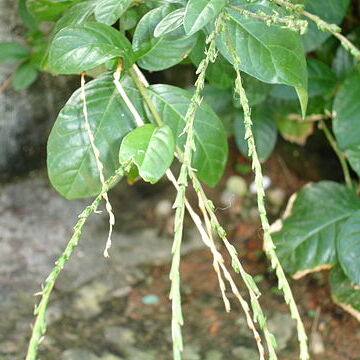Herbs or subshrubs, slightly woody at base. Leaves shortly petiolate; stipules present, minute. Inflorescences elongated, axillary or terminal spike-like racemes; flowers subsessile or pedicellate; bracteate and bracteolate. Flowers bisexual, more or less actinomorphic; tepals 4, free or partly united in a short tube, lobes spreading in flower, persistent, enlarging and erect in fruit; stamens 4-8, on a hypogynous disk, filaments unequal, shorter than tepals, anthers seemingly medifixed, linear; ovary 1-loculed, narrowly subellipsoid or oblongoid, flattened, pilose or tomentose, with 4-6 retrorse hook-like awns, ovule 1, style absent, stigma 1, papillose, penicillate and laterally decurrent along ventral (flattened) side of ovary. Fruits 2-lobed achenes with 4-6 apical hooked awns; seed 1, linear, testa membranous, adherent to pericarp, albumen scanty, mealy, cotyledons foliaceous.
Herbs or subshrubs, perennial, slightly woody at base. Leaves alternate. Inflorescences terminal or axillary, virgate, spikelike racemes, 8-30-flowered. Flowers: sepals 4; stamens 4-8; carpels 1; ovary 1-loculed; style absent; stigma 1. Fruits achenes, elongate-cuneate, apically 2-lobed, each lobe tipped with 1-3 sharply reflexed spines 3-5 mm. Seed 1.

